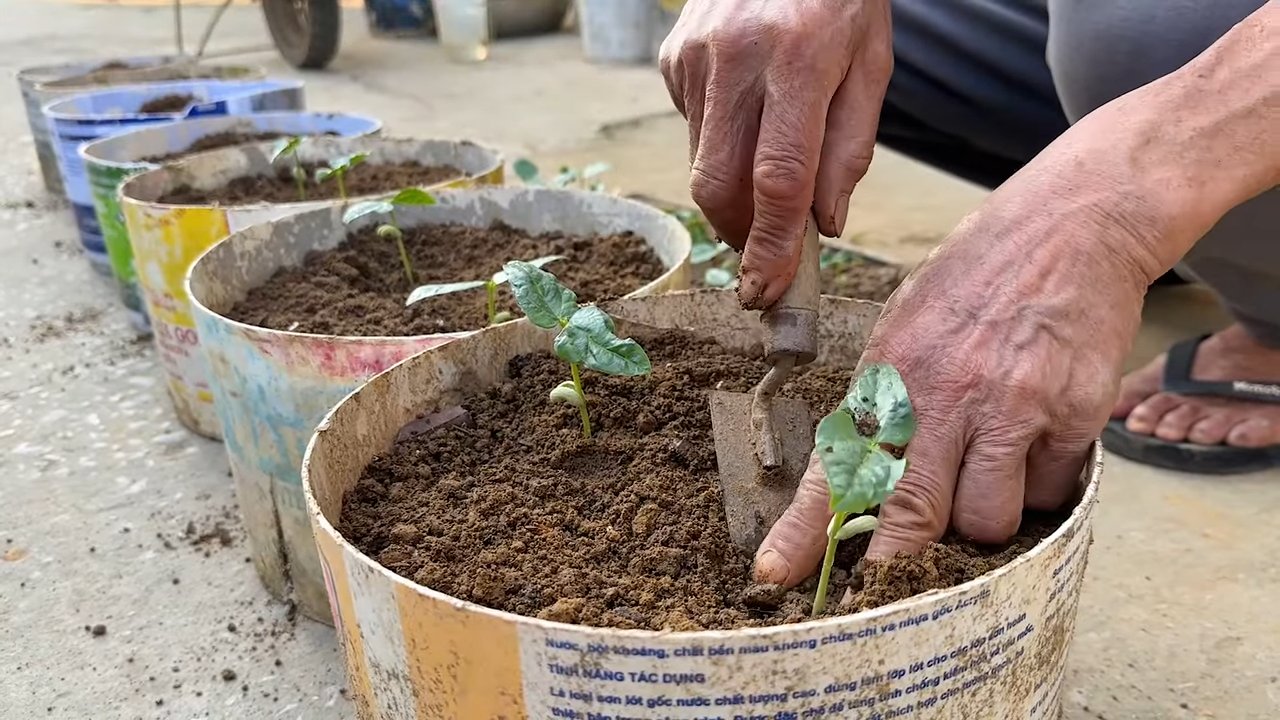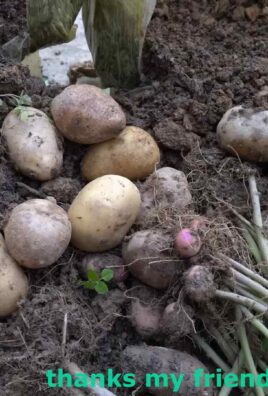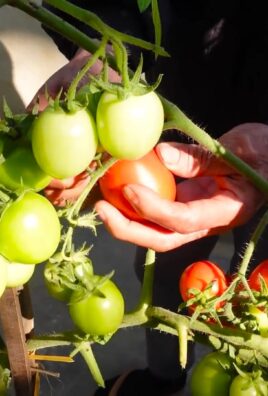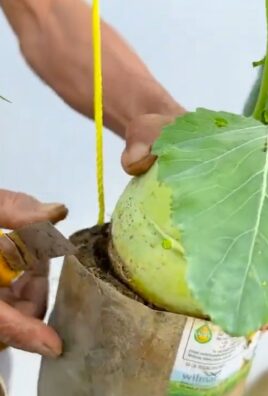Grow Yardlong Beans Harvest: Imagine stepping into your backyard and harvesting beans that are literally a yard long! It sounds like something out of a fairytale, doesn’t it? But trust me, with a few simple tricks, you can make this a reality. For centuries, beans have been a staple crop in cultures around the world, providing essential nutrients and playing a vital role in sustainable agriculture. Yardlong beans, also known as asparagus beans or Chinese long beans, are a unique and fascinating variety that offers both delicious flavor and impressive visual appeal.
But why should you bother with these extra-long legumes? Well, for starters, they’re incredibly productive! A single plant can yield a surprising amount of beans, making them perfect for small gardens or even container gardening. Plus, they’re packed with vitamins and minerals, making them a healthy and delicious addition to your meals. I’ve found that learning how to grow yardlong beans harvest successfully is easier than you might think, and I’m excited to share some DIY tricks and hacks that will help you maximize your yield and enjoy a bountiful harvest. So, grab your gardening gloves, and let’s get started!

Growing and Harvesting Yardlong Beans: Your Comprehensive DIY Guide
Hello garden friends! I’m thrilled to introduce you today to the fascinating world of yardlong bean cultivation. These long, slender beauties are not only an eye-catcher in the garden but also incredibly delicious and versatile in the kitchen. In this article, I’ll show you step-by-step how to successfully grow and harvest your own yardlong beans. Let’s get started!
What are Yardlong Beans Anyway?
Yardlong beans, also known as asparagus beans or Chinese snake beans (Vigna unguiculata subsp. sesquipedalis), are a subspecies of the cowpea. They are famous for their extremely long pods, which can grow up to a meter in length! They have a mild, slightly sweet taste and a crisp texture. They are rich in vitamins, minerals, and fiber, making them a healthy addition to any meal.
Why Grow Yardlong Beans?
- Unique Appearance: The long, hanging pods are a real eye-catcher in the garden.
- High Yield: A single plant can produce an impressive amount of beans.
- Healthy and Delicious: Yardlong beans are rich in nutrients and have a delightful taste.
- Versatile in the Kitchen: They can be stir-fried, steamed, grilled, or used in salads.
- Easy to Grow: With the right tips and tricks, growing yardlong beans is child’s play.
Preparation is Everything: The Right Location and Soil
Before we start planting, it’s important to prepare the right location and soil. Yardlong beans love the sun and need at least 6-8 hours of direct sunlight per day. The soil should be well-draining, loose, and rich in organic matter.
Here are some tips for preparing the soil:
- Soil Analysis: Conduct a soil analysis to determine the pH value and nutrient content. Yardlong beans prefer a pH value between 6.0 and 7.0.
- Soil Improvement: Improve the soil with compost, well-rotted manure, or other organic materials. This improves drainage, aeration, and nutrient content.
- Soil Loosening: Loosen the soil thoroughly to promote root development.
- Weed Control: Remove all weeds before you start planting.
Sowing and Cultivation: The Start of the Season
Yardlong beans are heat-loving and should only be sown after the last frost. You can either sow the seeds directly outdoors or start them in pots.
Direct Sowing:
- Choose the Right Time: Sow the seeds only when the soil temperature is at least 18°C (64°F).
- Prepare the Soil: Loosen the soil and remove any weeds.
- Sow the Seeds: Sow the seeds 10-15 cm (4-6 inches) apart and 2-3 cm (1 inch) deep.
- Water the Seeds: Water the seeds carefully to keep the soil moist.
- Protect the Seedlings: Protect the seedlings from pests and slugs.
Starting in Pots:
- Choose the Right Pots: Use small pots or seedling trays with good drainage.
- Fill Pots with Seed Starting Mix: Use high-quality seed starting mix that is well-draining.
- Sow the Seeds: Sow 2-3 seeds per pot at a depth of 2-3 cm (1 inch).
- Water the Seeds: Water the seeds carefully to keep the soil moist.
- Place Pots in a Warm, Bright Location: The seeds need warmth and light to germinate.
- Pricking Out: Once the seedlings have 2-3 true leaves, you can prick them out into larger pots.
- Hardening Off: Before planting the seedlings outdoors, you should harden them off for a few days by placing them outside during the day and bringing them back in at night.
Planting and Trellis: Giving the Beans Support
Yardlong beans are climbing plants and need a trellis to grow. You can provide them with a fence, a trellis, a teepee, or another sturdy structure.
Planting:
- Choose the Right Time: Only plant the young plants outdoors when there is no longer a risk of frost.
- Prepare the Soil: Loosen the soil and remove any weeds.
- Plant the Young Plants: Plant the young plants 30-45 cm (12-18 inches) apart along the trellis.
- Water the Plants: Water the plants thoroughly to keep the soil moist.
- Mulch the Soil: Mulch the soil around the plants to retain moisture and suppress weeds.
Trellis:
- Fence: A fence is a simple and effective way to support yardlong beans.
- Trellis: A trellis is a decorative support that adds a touch of elegance to the garden.
- Teepee: A teepee is a fun and creative support that is especially popular with children.
- Homemade: You can also build your own trellis from bamboo stakes, branches, or other materials.
Care and Fertilization: For Healthy Plants and Abundant Harvest
Yardlong beans are relatively easy to care for, but regular watering, fertilization, and weed control are important for a bountiful harvest.
Watering:
- Water the plants regularly, especially during dry periods.
- Avoid waterlogging, as this can lead to root rot.
- It’s best to water in the morning so the leaves can dry during the day.
Fertilization:
- Fertilize the plants every 2-3 weeks with an organic fertilizer rich in nitrogen, phosphorus, and potassium.
- You can also use compost tea or diluted nettle manure.
- Avoid over-fertilization, as this can lead to excessive leaf growth and fewer flowers.
Weed Control:
- Regularly remove weeds to reduce competition for nutrients and water.
- Mulch the soil to suppress weed growth.
Pest Control:
- Regularly inspect plants for pests such as aphids, spider mites, and bean weevils.
- Remove pests by hand or use natural pest control methods like neem oil or insecticidal soap.
Harvest Time: The Reward for Your Labor
Harvest time for yardlong beans typically begins about 60-70 days after sowing. The beans are ready to harvest when they are about 30-60 cm (12-24 inches) long and still tender and crisp.
Harvesting Tips:
Store harvested beans in the refrigerator.
Harvest beans regularly to encourage the production of new pods.
Cut the beans with scissors or a knife to avoid damaging the plant.
It’s best to harvest beans in the morning when they are still cool and fresh.

Conclusion
So, there you have it! Mastering the art of growing and harvesting your own yardlong beans is not only achievable but incredibly rewarding. We’ve walked through the process, from selecting the right seeds and preparing your garden to providing essential support and knowing exactly when to pluck those impressive, elongated pods.
Why is this DIY trick a must-try? Because nothing compares to the taste of freshly harvested, homegrown vegetables. The vibrant flavor and crisp texture of yardlong beans, picked at their peak ripeness, are simply unmatched by anything you can find in a store. Plus, you have complete control over the growing process, ensuring your beans are free from harmful pesticides and chemicals. You’re not just growing food; you’re cultivating a healthier lifestyle.
Beyond the superior taste and health benefits, growing yardlong beans is a fantastic way to connect with nature, learn about the growing cycle, and even save money on your grocery bill. It’s a sustainable practice that contributes to a more environmentally friendly way of living.
Ready to take your yardlong bean game to the next level? Consider these variations and suggestions:
* Trellis Innovations: Experiment with different trellis designs. While a simple bamboo structure works wonders, you could also try using repurposed materials like old ladders or even creating a living trellis with sunflowers.
* Companion Planting: Enhance your yardlong bean patch by incorporating companion plants like marigolds (to deter pests) or basil (to improve flavor).
* Seed Saving: Once you’ve successfully grown your yardlong beans, save some of the seeds for next year’s planting. This ensures a continuous supply of your favorite variety and adapts the beans to your specific growing conditions.
* Culinary Explorations: Don’t limit yourself to stir-fries! Yardlong beans are incredibly versatile. Try them in salads, soups, stews, or even pickled for a tangy treat. Explore different cuisines and discover new ways to enjoy your harvest.
* Succession Planting: Extend your harvest season by planting new seeds every few weeks. This will ensure a continuous supply of fresh yardlong beans throughout the summer and fall.
We’re confident that with a little effort and the knowledge you’ve gained here, you’ll be enjoying a bountiful harvest of delicious yardlong beans in no time. Don’t be afraid to experiment, learn from your mistakes, and most importantly, have fun!
Now, we want to hear from you! Have you tried growing yardlong beans before? What challenges did you face, and what successes did you celebrate? Share your experiences, tips, and photos in the comments below. Let’s create a community of yardlong bean enthusiasts and learn from each other. Your insights could be invaluable to other gardeners embarking on this rewarding journey. So, get your hands dirty, embrace the process, and let’s grow some amazing yardlong beans together! We can’t wait to see what you create.
Frequently Asked Questions (FAQ)
What are yardlong beans, and why should I grow them?
Yardlong beans, also known as asparagus beans or Chinese long beans, are a type of legume characterized by their exceptionally long pods, often reaching lengths of up to three feet. They offer a unique flavor profile, somewhere between a green bean and asparagus, and are packed with nutrients like vitamins A and C, fiber, and folate. Growing them yourself ensures you have access to fresh, pesticide-free produce, and it’s a rewarding gardening experience. Plus, their impressive length makes them a conversation starter!
How much space do yardlong beans need?
Yardlong beans are vigorous climbers and require vertical support. Each plant needs about 6-12 inches of space along a trellis or fence. Ensure your trellis is sturdy enough to support the weight of the mature plants and their abundant pods. A trellis that is 6-8 feet tall is ideal.
When is the best time to plant yardlong beans?
Yardlong beans are warm-season crops and should be planted after the last frost when the soil temperature has warmed to at least 65°F (18°C). In most regions, this is typically in late spring or early summer. You can start seeds indoors 3-4 weeks before the last frost to get a head start, but be careful when transplanting to avoid disturbing the roots.
What kind of soil is best for growing yardlong beans?
Yardlong beans thrive in well-drained, fertile soil with a pH between 6.0 and 7.0. Amend your soil with compost or other organic matter before planting to improve drainage and nutrient content. Avoid heavy clay soils, as they can become waterlogged and hinder root development.
How often should I water yardlong beans?
Yardlong beans need consistent moisture, especially during flowering and pod development. Water deeply and regularly, aiming for about 1 inch of water per week. Avoid overhead watering, as this can promote fungal diseases. Mulching around the base of the plants helps retain moisture and suppress weeds.
Do yardlong beans need fertilizer?
While yardlong beans are relatively low-maintenance, they benefit from occasional fertilization. Apply a balanced fertilizer (e.g., 10-10-10) at planting time and again when the plants begin to flower. Avoid over-fertilizing with nitrogen, as this can promote leafy growth at the expense of pod production.
What are some common pests and diseases that affect yardlong beans?
Common pests include aphids, bean beetles, and spider mites. Control these pests with insecticidal soap or neem oil. Diseases like powdery mildew and fungal leaf spots can also affect yardlong beans. Prevent these diseases by providing good air circulation, avoiding overhead watering, and applying a fungicide if necessary.
How do I know when yardlong beans are ready to harvest?
Yardlong beans are typically ready to harvest 60-80 days after planting. The pods should be firm, slender, and about 12-18 inches long. Harvest them before the seeds inside become too large and the pods become tough. Regular harvesting encourages continued pod production.
Can I eat the leaves of yardlong beans?
While the primary focus is on the pods, the young leaves of yardlong beans are also edible and can be used in salads or stir-fries. However, it’s best to harvest them sparingly to avoid stressing the plant.
How do I store yardlong beans after harvesting?
Freshly harvested yardlong beans can be stored in the refrigerator for up to a week. Place them in a plastic bag or container to prevent them from drying out. You can also freeze yardlong beans for longer storage. Blanch them in boiling water for 2-3 minutes, then cool them in ice water before freezing.
Can I grow yardlong beans in containers?
Yes, yardlong beans can be grown in containers, but you’ll need a large pot (at least 12 inches in diameter) and a sturdy trellis. Choose a well-draining potting mix and provide regular watering and fertilization. Container-grown yardlong beans may require more frequent watering than those grown in the ground.
What are some good companion plants for yardlong beans?
Good companion plants for yardlong beans include marigolds (to deter pests), basil (to improve flavor and repel insects), and carrots (to improve soil structure). Avoid planting yardlong beans near onions or garlic, as they can inhibit growth.
How can I save seeds from my yardlong beans?
To save seeds, allow some of the pods to mature fully on the vine until they are dry and brown. Remove the seeds from the pods and dry them thoroughly before storing them in an airtight container in a cool, dark place.
Are yardlong beans the same as green beans?
No, yardlong beans are not the same as green beans. While they are both legumes, yardlong beans have a distinct flavor and texture, and their pods are significantly longer. They also belong to a different species (Vigna unguiculata subsp. sesquipedalis) than common green beans (Phaseolus vulgaris).





Leave a Comment